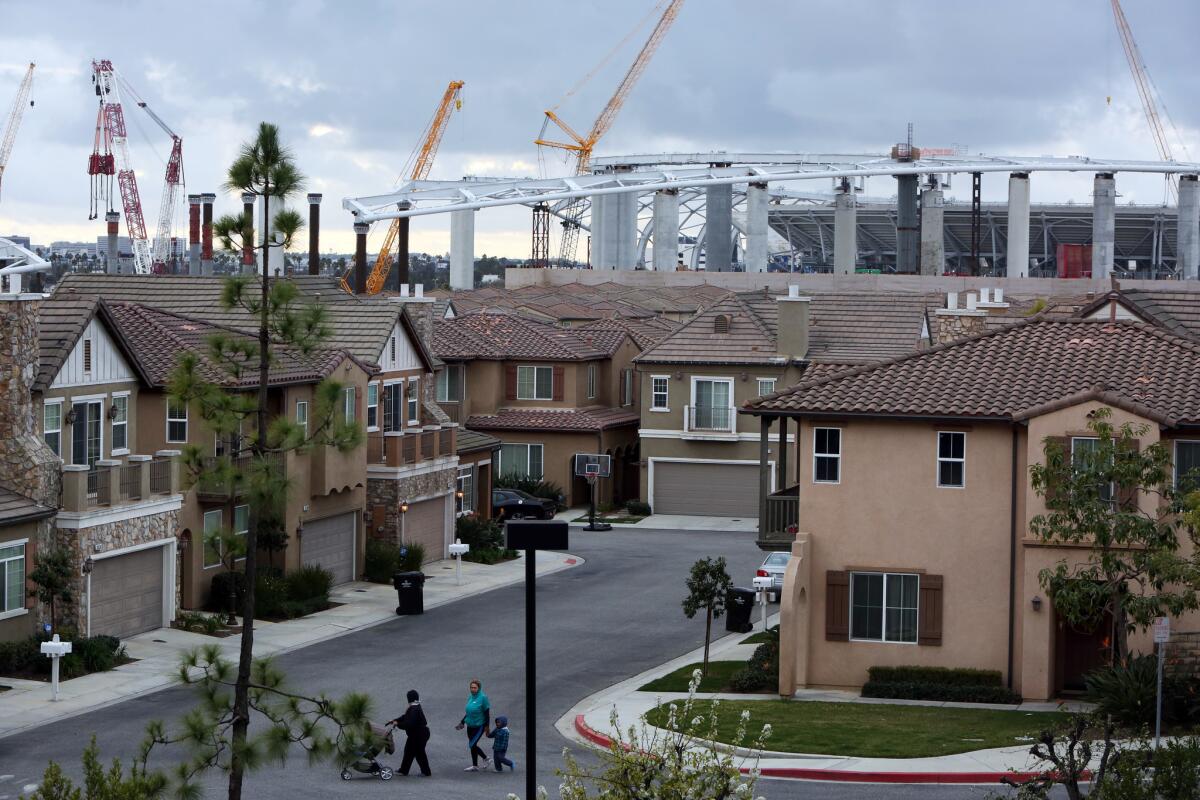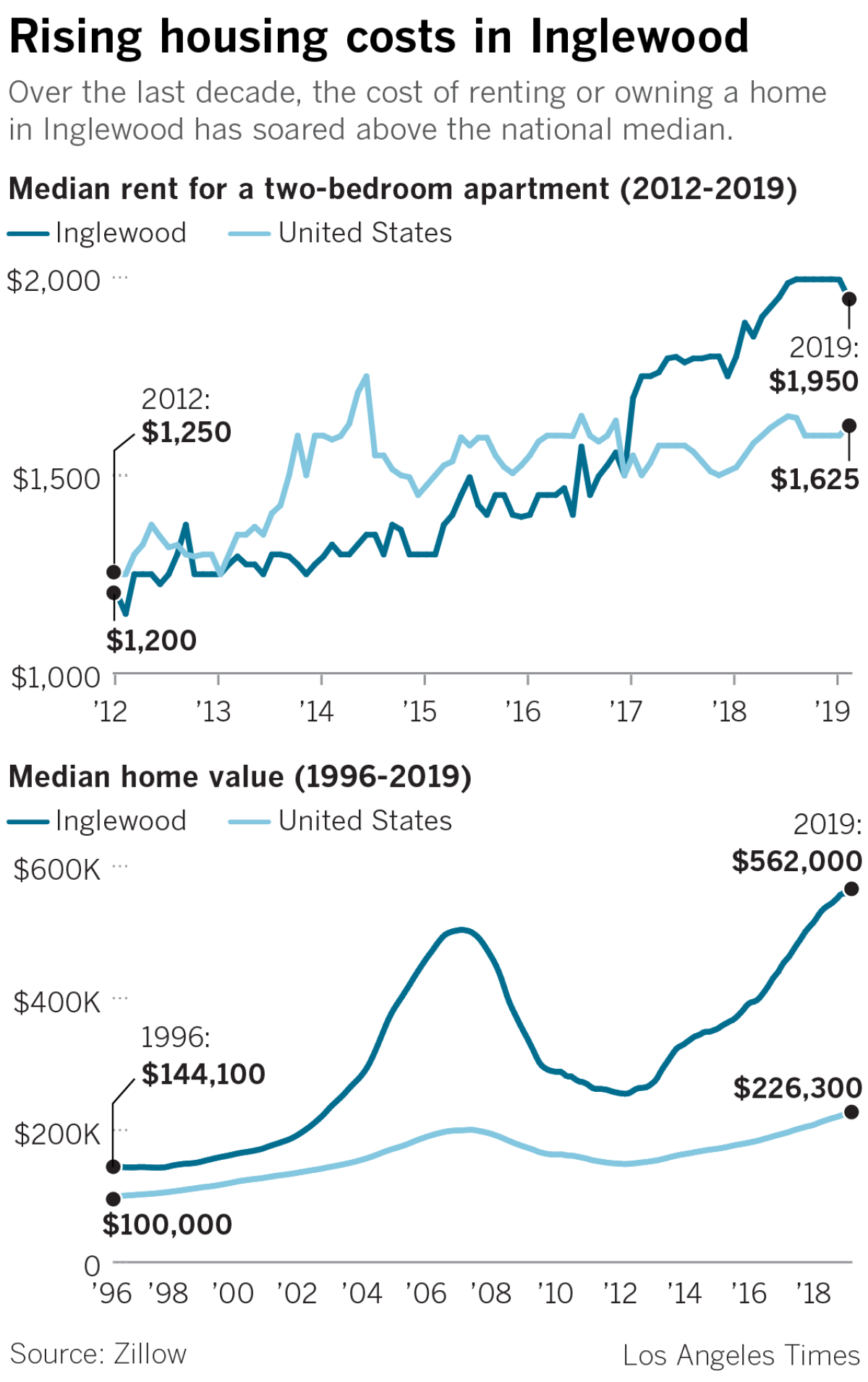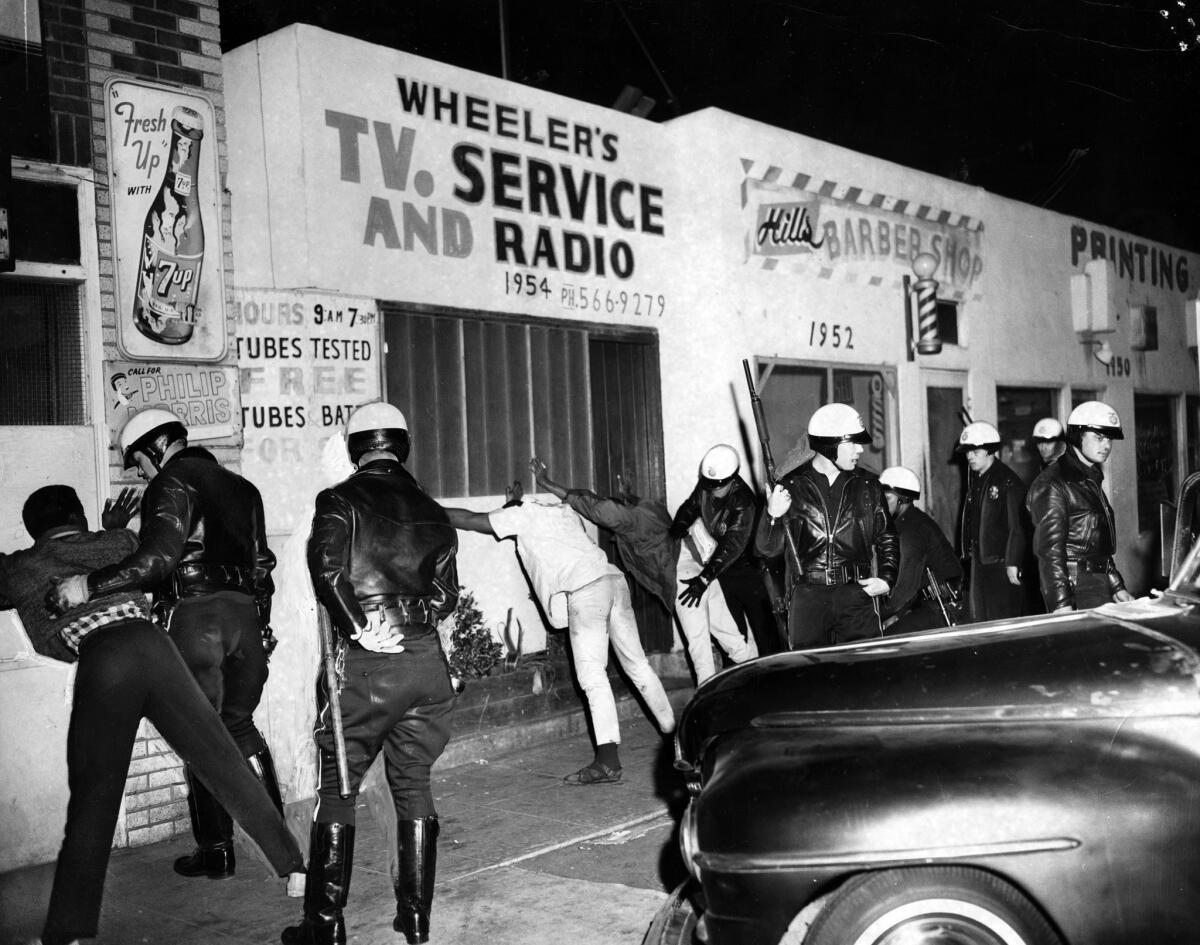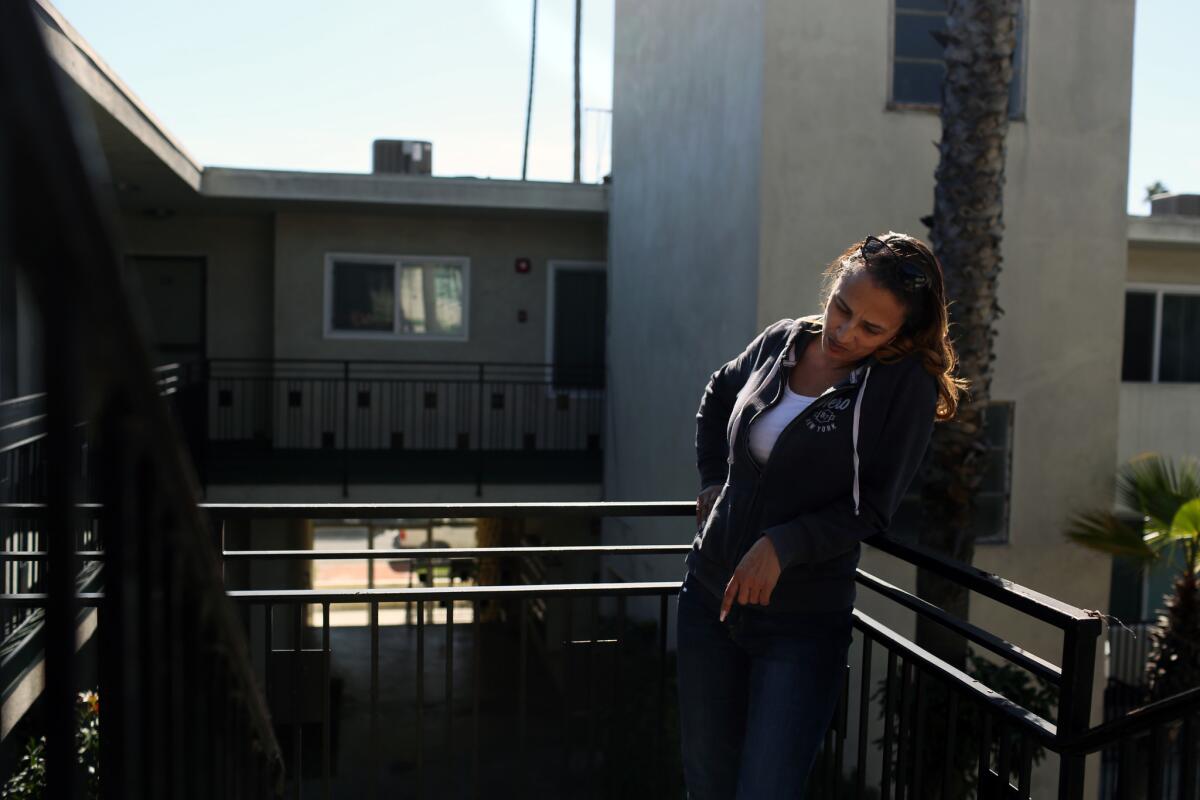Must Reads: One of California’s last black enclaves threatened by Inglewood’s stadium deal

He’s lived in his Inglewood apartment for 23 years. Then his rent doubled. Now, at 69, Major Stewart is moving into his family’s home.
Inglewood has come a long way since Dr. Dre proclaimed in the ’90s that it was “always up to no good.”
A surge of economic development is wiping away its reputation as a battle zone for rival gangs and promises to remake the city not only into a sports and entertainment mecca but also a cultural destination.
But now that Inglewood is on the come up, longtime residents and city officials face a different challenge: Many who have weathered decades of hardship no longer can afford to live there and are being left out of the economic renaissance.
Donald Martin, 67, lost the roof over his head after a new landlord evicted him with just 60 days’ notice from the building he had lived in for almost a decade.
Tomisha Pinson, who lives next door to the new L.A. Rams and Chargers stadium and entertainment complex, received a notice that the monthly rent on her two-bedroom Inglewood apartment would spike from $1,145 to $2,725.
“It makes you feel pushed out, like, ‘We don’t need you guys no more, the upper class is going to be moving in,’ ” said Pinson, 43, a mother of two who takes in foster children.
As home prices soar and rents rise, Inglewood is struggling to meet its goal of encouraging more investment while trying to preserve one of California’s last remaining African American enclaves.
“Inglewood is the ‘City of Champions’ and like all good champions, Inglewood is rising again,” said Daniel Tabor, a former mayor and councilman. “But it has been a missed opportunity for economic participation by the residents and local businesses.”
Not long ago, the city was struggling with decades of decline exacerbated by the loss of two economic engines, the Lakers and Hollywood Park racetrack. Now, the white skeleton of the $2.6-billion NFL stadium and entertainment district is rising along Century Boulevard. Plans for a new L.A. Clippers arena are crystallizing. A $14.5-million Frank Gehry-designed home for the L.A. Philharmonic’s youth orchestra is underway, and the Girl Scouts of Greater Los Angeles moved its regional headquarters to Inglewood last February.
“We all know when the Girl Scouts come, it’s all over,” Mayor James T. Butts Jr. joked to a group of homeowners last year. In his view, the Scouts’ arrival pins a badge of safety on his city, in turn luring still more investment.
All these attractions will become easier to visit with next year’s scheduled opening of the $2-billion, 8.5-mile Crenshaw light rail line.
But activists are pressing City Hall, demanding officials do more to protect residents against ballooning rents. In March, the city adopted a temporary cap on increases and evictions. But some say the measure is too little, too late.
Uplift Inglewood, a tenants’ rights group, is suing the city and a developer to halt construction of the Clippers arena, a project that would allow the city to use eminent domain to confiscate property at the southwest corner of Century Boulevard and Prairie Avenue. The lawsuit alleges that the city’s proposed sale of public land to build the Clippers project violates state law that requires prioritizing the use of such land for affordable housing.
D’Artagnan Scorza, 38, who sits on the city’s school board, said he helped create Uplift Inglewood to give a voice to vulnerable renters. He knows their plight. When he was a grade-schooler, his family was evicted from their Inglewood townhouse; they couldn’t afford the rent.
Although he supports the football stadium project, he wants to use it to leverage development and investment to benefit blacks and Latinos, who account for an estimated 42% and 51%, respectively, of Inglewood residents.
“We wanted to be a model for investment without displacement,” Scorza said. “We didn’t want that capital to come in and flood out the folk who live here.”
At the center of the fray is Mayor Butts, who was reelected to a third term in 2018 with 63% of the vote.
While in office, he has tried to juggle seemingly opposing goals: courting pharaonic projects like the NFL stadium while persuading landlords to keep rents stable and trying to ensure that longtime owners reap the benefits of a thriving market that has pushed the median home value in this city of 110,000 to $555,000.
Lack of rent control makes Inglewood an attractive investment opportunity. Owners have been able to jack up rents or kick out month-to-month tenants with just 60 days’ notice. Two-thirds of the city’s residents are renters. About a quarter who live here are older than 55. Many are on fixed incomes.
At the March 5 City Council meeting, Butts proposed — and the council unanimously voted to adopt — a 45-day moratorium during which rent increases would be capped at 5% annually and evictions would be halted as the city tried to find a permanent solution to the rent problem. There’s an option to extend the measure to a full year.
Previously, Butts had opposed rent ordinances, saying: “We’re not going to do anything to stymie the small owners from being able to make a living.”
But Inglewood’s housing market has changed drastically since he was elected in 2011.
Back then, the city was on the verge of bankruptcy. Services were being trimmed, and unemployment amid the Great Recession stood at 17%. The city’s largest taxpayer, Hollywood Park Racetrack and Casino — which in 2011 brought $4.6 million into the city’s coffers — was shuttering its racetrack.

Developers say their investments have spurred Inglewood’s reversal of fortune. In 2018, the site where the 300-acre stadium project is going up brought in $15.8 million in tax revenue — without a single game being played. That money has been used to restore services, hire more police officers and replace the aging fleet of cop cars, Butts said.
Inglewood’s post-recession jobless rate is now 5.4%. But there’s a downside to the boom: a growing housing shortage. Despite the city’s turnaround, said Chris Meany, co-founder of the developer involved in the NFL stadium and Clippers projects, “when a place is being economically redeveloped, always in the back of your mind is, ‘Are we gentrifying to the point we’re displacing people?’ ”
Years before the stadium plan came into being, the same developer had proposed building a retail and residential community with 3,000 housing units — 450 of which would be affordable — at the racetrack site. The project would have included upscale, market-rate housing to attract high-income earners and raise the city’s tax base.

In 2008, city officials and developers agreed to spread the affordable units throughout the city. Now, when completed, the stadium-entertainment complex will include Inglewood’s largest housing project, with 2,500 units. None are set aside for low-income residents.
Butts said the city had constructed hundreds of affordable units since he took office and that another 180 would be added over the next three years.
But Inglewood is a long way from fulfilling its 2021 housing goal of 567 below-market units. It hasn’t produced any affordable housing since the end of 2013, when all L.A. County cities were required to set goals for the next seven years, according to the state’s Department of Housing and Community Development.
Russ Heimerich, a spokesman for the state Business, Consumer Services and Housing Agency, said many communities had failed to meet their targets.
“The whole state of California is behind in producing housing,” he said.
With a median household income of $46,000, roughly $15,000 below the county’s median, Inglewood has joined a growing list of urban areas nationwide, from Baltimore to Oakland, where African Americans have historically clustered — for comfort or because of race-based redlining policies — but now feel they are being pushed out. Nationwide, black homeownership rates have declined to levels not seen since the 1960s, when race-based discrimination was legal, according to nonprofit think tank the Urban Institute, a sign that the economic recovery has skipped many workers of color.
“This is our ’hood,” said Major Stewart, 69, who lived in Inglewood for 36 years before getting a notice in December that rent on his one-bedroom apartment two miles from the new stadium would more than double. So he’s moving in with his sister in L.A. “If you move us out of here, we’re lost.”
‘This is our ’hood. If you move us out of here, we’re lost.’
— Major Stewart, Inglewood resident
African Americans have felt unwelcome in Inglewood before.
A century ago, signs posted by the Ku Klux Klan declared the city to be for “Caucasians-Only.” The post-WWII era brought a wave of African Americans escaping the Jim Crow South for the dream of living where race was not the “principal organizing factor,” said Darnell Hunt, director of the Ralph J. Bunche Center for African American Studies at UCLA.
“California was never a slave state,” he said, “so all of those things made it attractive for blacks coming from places where racial segregation and oppression was in your face every day.”
Many of the transplants secured good-paying jobs in the defense industry. But as more blacks arrived, Jim Crow followed. Realtors refused to show them homes. Racial covenants tucked into property deeds prohibited selling to blacks, keeping large swaths of present-day South L.A. and Inglewood Caucasian.

A series of state and federal laws made housing discrimination illegal. But it took the 1965 Watts riots to truly integrate Inglewood, as middle-class blacks moved farther west in search of a place to lay down community roots.
By 1970, one in 10 Inglewood residents were black. But as the region’s manufacturing base shrank, high-paying union jobs disappeared. Industry trends and the shift in residents’ spending power caused many of the city’s businesses to close.
The Lakers and Kings moved to downtown L.A. in 1999. Efforts to revitalize Inglewood’s Market Street failed. The state took over the city’s troubled schools in 2012. Hollywood Park held its final race the following year.
“Inglewood was in decline” and edging toward insolvency, said Meany, the developer.
Then with the NFL stadium plans came a surprising revival. The growth of the technology sector in Playa Vista’s Silicon Beach also began to change Inglewood, much as the tech boom has spilled into black communities in Oakland, Boston and Seattle. Newcomers with higher salaries found their dollar could stretch further.
The city’s image also has been buffed by positive pop-culture imagery, such as HBO’s hit comedy-drama “Insecure,” depicting the trials and triumphs of its 20-something black female protagonist who lives in Inglewood.
“ ‘Insecure’ does a pretty good job of showing the world the other side of South L.A.,” Hunt said, “that maybe you didn’t see if all you saw were the gangster movies of the 1990s and everything that came after the 1992 uprising” with the Rodney King trial.
For Clarence Johnson, buying an Inglewood home was a gamble that paid off.
The 34-year-old father of two found a duplex that fit his budget, nestled on a tree-lined street off West 102nd Street. He lives in one unit and rents out the other.
When he moved to Inglewood in 2011, he said, parts of the city resembled a rap video — people with intimidating stares clustered on street corners. When he used to tell people where he lived, they replied, “You can always move. Inglewood is a good start.”
Now they ask if he lives near the stadium, and his home value has more than doubled.
Butts has admitted to underestimating the rent-increase problem, once thinking it could be solved on a case-by-case basis.
Over the last few years, the mayor said, he would reach out to residents when rumors of price gouging and displacement surfaced online but often did not hear back. Then in January, an outraged tenant posted on Facebook that her rent would jump from $1,200 to $2,725 per month.
Butts got word of a rental increase of more than 100% in the nine-unit, sand-colored apartment building where Major Stewart lived. Not longer after that building changed hands late last year, the new owner tucked notices of rent increases into tenants’ screen doors. Stewart was informed that his rent would jump to $1,725 from $855. There were no promises to make improvements, like replacing his aging carpet or appliances, Major Stewart said.

Increase notices also went out at Tomisha Pinson’s 28-unit complex, which was owned by the same property management company, and Butts stepped in.
He met days later with Adrian Malin, the head of Regents 99 LLC, and crafted an agreement that gave renters in the two apartment buildings several choices, including gradual increases or a $10,000 lump sum to move out by April.
“It was somewhat of a victory for us,” said 40-year-old Angel Burrell, a longtime resident who plans to take the lump sum and move into a family-owned duplex in Inglewood.
Malin declined to comment but in an email wrote: “I have a lot of respect for Mayor Butts.”
But the community’s triumph was short-lived.
In February, Butts learned of two more properties that had experienced sharp rent hikes. The property manager refused to speak with him, prompting the mayor to propose the 45-day rent moratorium.
‘Everybody can agree that these 120% rent increases are astronomical and ridiculous. I think we can start there.’
— D’Artagnan Scorza, of Uplift Inglewood
The temporary cap was a win for Uplift Inglewood, which continues to apply pressure to City Hall. It also is taking the fight to Sacramento, pushing for an anti-price-gouging bill.
“Everybody can agree that these 120% rent increases are astronomical and ridiculous,” said Scorza, of Uplift Inglewood. “I think we can start there.”
But the cap wasn’t enough to keep Donald Martin in Inglewood.
Golden Bee Properties took over his 10-unit building last year. The new landlord never issued a notice about raising the rent. Instead, Martin was evicted with 60 days’ notice.
Golden Bee’s top executive, David Berneman, declined to comment.
There’s no way to know how many tenants have been pushed from their homes without cause; some eviction notices are available for viewing for 60 days, but many are not public record.
When he left, Martin said, Golden Bee Management gave him a month’s rent plus $500. He boxed up his suits, his favorite alligator shoes that he only wears to church, and some cooking supplies. He put it all in storage.
For weeks, Martin parked his SUV in a strip mall and slept in the front seat before the police ordered him to leave. Now he is living out of motels and extended-stay hotels.
“I can’t save money, because the rent of some places I live is $500 a week,” said Martin, who receives a disability check for back pain. “It has been really rough on me.”
On a recent afternoon, he returned to his old neighborhood to visit friends, driving past the building where he thought he would live out his golden years.
The exterior had been painted a lime green with gray-blue trim. A crew of workers streamed in and out, readying the apartments for tenants willing to pay market rent.
For more California breaking news, follow @AngelJennings. She can also be reached at [email protected].
Sign up for Essential California
The most important California stories and recommendations in your inbox every morning.
You may occasionally receive promotional content from the Los Angeles Times.








